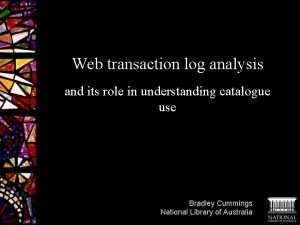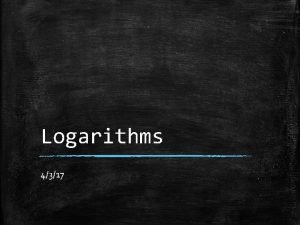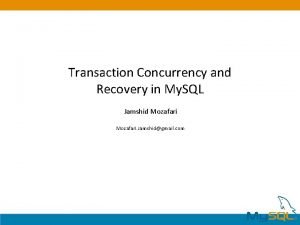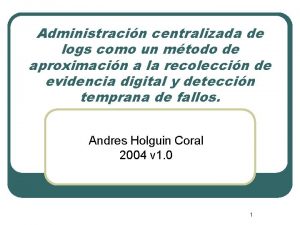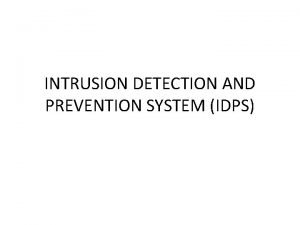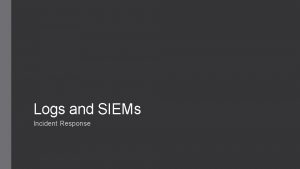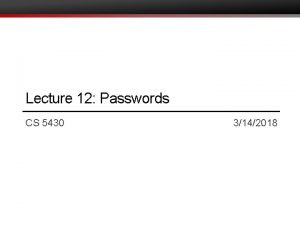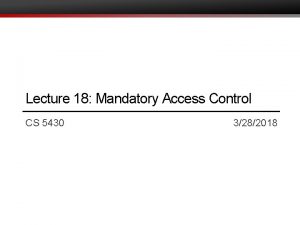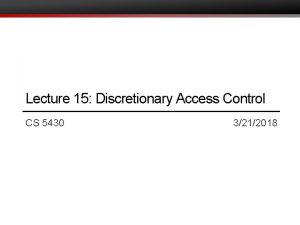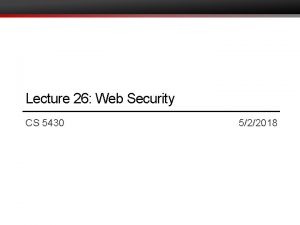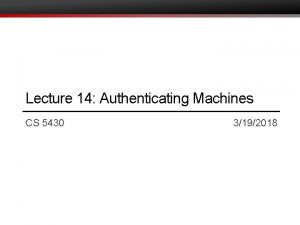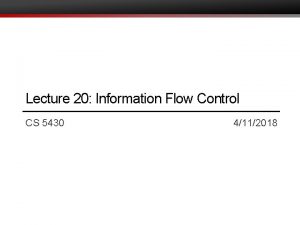Lecture 23 Reviewing Logs CS 5430 4232018 Classes






![Interfaces • Flat text [example: last time's syslog] • Hypertext [example] • DBMS [example: Interfaces • Flat text [example: last time's syslog] • Hypertext [example] • DBMS [example:](https://slidetodoc.com/presentation_image_h2/a621eb89543b434fb652e4c64805b15b/image-7.jpg)
![Techniques • Temporal replay: animate what happened when [example] • Slice: display minimal set Techniques • Temporal replay: animate what happened when [example] • Slice: display minimal set](https://slidetodoc.com/presentation_image_h2/a621eb89543b434fb652e4c64805b15b/image-8.jpg)






![Identification methodologies [Denning 1987] 1. Signature based: recognize known attacks 2. Specification based: recognize Identification methodologies [Denning 1987] 1. Signature based: recognize known attacks 2. Specification based: recognize](https://slidetodoc.com/presentation_image_h2/a621eb89543b434fb652e4c64805b15b/image-15.jpg)




![Example: Distributed Program Execution Monitor (DPEM) [Ko et al. 1997] • Monitors Unix audit Example: Distributed Program Execution Monitor (DPEM) [Ko et al. 1997] • Monitors Unix audit](https://slidetodoc.com/presentation_image_h2/a621eb89543b434fb652e4c64805b15b/image-20.jpg)


![Machine learning • Despite extensive academic research, “Machine learning [for IDS] is rarely employed Machine learning • Despite extensive academic research, “Machine learning [for IDS] is rarely employed](https://slidetodoc.com/presentation_image_h2/a621eb89543b434fb652e4c64805b15b/image-23.jpg)


![Intrusion handling [Northcutt 1998] 1. Preparation 2. Identification 3. Containment 4. Eradication 5. Recovery Intrusion handling [Northcutt 1998] 1. Preparation 2. Identification 3. Containment 4. Eradication 5. Recovery](https://slidetodoc.com/presentation_image_h2/a621eb89543b434fb652e4c64805b15b/image-26.jpg)


- Slides: 28

Lecture 23: Reviewing Logs CS 5430 4/23/2018

Classes of Countermeasures • Authentication: mechanisms that bind principals to actions • Authorization: mechanisms that govern whether actions are permitted • Audit: mechanisms that record and review actions

Uses of audit • Individual accountability: deter misbehavior • Event reconstruction: determine what happened and how to recover • Problem monitoring: real-time intelligence

Audit tasks • Recording: • what to log • what not to log • how to protect the log • Reviewing: • manual exploration • automated analysis

MANUAL

Manual review • Enable administrators to explore logs and look for {states, events} • Issues: • Designers might not have anticipated the right {states, events} to record • Visualization, query, expressivity (HCI/DB issues) • Correlation amongst multiple logs
![Interfaces Flat text example last times syslog Hypertext example DBMS example Interfaces • Flat text [example: last time's syslog] • Hypertext [example] • DBMS [example:](https://slidetodoc.com/presentation_image_h2/a621eb89543b434fb652e4c64805b15b/image-7.jpg)
Interfaces • Flat text [example: last time's syslog] • Hypertext [example] • DBMS [example: queries in CMS] • Graph (nodes might be entities like processes and files, edges might be associations like forking or times) [example]
![Techniques Temporal replay animate what happened when example Slice display minimal set Techniques • Temporal replay: animate what happened when [example] • Slice: display minimal set](https://slidetodoc.com/presentation_image_h2/a621eb89543b434fb652e4c64805b15b/image-8.jpg)
Techniques • Temporal replay: animate what happened when [example] • Slice: display minimal set of log events that affect a given object

AUTOMATIC

Automated review and response • Review: detect suspicious behavior that looks like an attack, or detect violations of explicit policy • Custom-built systems • Classic AI techniques like training neural nets, expert systems, etc. • Modern applications of machine learning • Response: report, take action

INTRUSION DETECTION

Intrusion detection system (IDS): • automated review and response • responds in (nearly) real time • components: • sensors • analysis engine • countermeasure deployment • audit log

Example: Network monitoring • Suspicious behavior: opening connections to many hosts • Automated response: router reconfigures to isolate suspicious host on its own subnet with access only to (e. g. ) virus scanner download, notifies administrators • Issue: errors. . .

Errors • False positive: raise an alarm for a non-attack • makes administrators less confident in warnings • perhaps leading to actual attacks being dismissed • False negative: not raise an alarm for an attack • the attackers get in undetected! • Tradeoff between the two needs to be tunable; difficult to achieve the right classification statistics
![Identification methodologies Denning 1987 1 Signature based recognize known attacks 2 Specification based recognize Identification methodologies [Denning 1987] 1. Signature based: recognize known attacks 2. Specification based: recognize](https://slidetodoc.com/presentation_image_h2/a621eb89543b434fb652e4c64805b15b/image-15.jpg)
Identification methodologies [Denning 1987] 1. Signature based: recognize known attacks 2. Specification based: recognize bad behavior 3. Anomaly based: recognize abnormal behavior

1. Signature-based detection • A. k. a. misuse detection and rule-based detection • Characterize known attacks with signatures • If behavior ever matches signature, declare an intrusion • Issues: • Works only for known attacks • Signature needs to be robust w. r. t. small changes in attack

Example: Snort # alert tcp $EXTERNAL_NET any -> $HOME_NET 53 ( msg: "OS-LINUX OS -LINUX x 86 Linux overflow attempt ADMv 2"; flow: to_server, established; content: "|89 F 7 29 C 7 89 F 3 89 F 9 89 F 2 AC|<|FE|", fast_pattern, nocase; metadata: ruleset community; service: dns; classtype: attempted-admin; sid: 265; rev: 15; )

Network-based IDS • Typically a separate machine • Stealth mode: • one NIC faces the network being monitored, no packets ever sent out on it, no packets can be routed specifically to it • another NIC faces a separate network through which alarms are sent • Honeypot: • dedicated machines(s) or networks • purpose is to look attractive to attacker • but actually just a trap: monitored to detect and surveil attacker

2. Specification-based detection • Characterize good behavior of program with a specification • If behavior ever departs from specification, declare an intrusion • Issues: • Effort to create specifications • Any program is a potential vulnerability if executed by a privileged user
![Example Distributed Program Execution Monitor DPEM Ko et al 1997 Monitors Unix audit Example: Distributed Program Execution Monitor (DPEM) [Ko et al. 1997] • Monitors Unix audit](https://slidetodoc.com/presentation_image_h2/a621eb89543b434fb652e4c64805b15b/image-20.jpg)
Example: Distributed Program Execution Monitor (DPEM) [Ko et al. 1997] • Monitors Unix audit logs • Analyst writes grammar in DSL to describe good behavior • Parser checks conformance of logs with grammar • Distributed because it combines information from multiple hosts

3. Anomaly-based detection • Characterize normal behavior of system • If behavior ever departs far enough from normal, declare an intrusion • Issues: • Feature identification • Obtaining data on what is normal

Statistical models • Threshold models: min and max • Moment models: mean and standard deviation • Markov models: probability of next event based on current state • Seems like a job for machine learning…
![Machine learning Despite extensive academic research Machine learning for IDS is rarely employed Machine learning • Despite extensive academic research, “Machine learning [for IDS] is rarely employed](https://slidetodoc.com/presentation_image_h2/a621eb89543b434fb652e4c64805b15b/image-23.jpg)
Machine learning • Despite extensive academic research, “Machine learning [for IDS] is rarely employed in…real world settings” [Sommer & Paxson 2010] • ML is great for classification: finding similarities • ML is not as great at outlier detection: here, “normal vs. abnormal” • ML in adversarial setting not well understood

Identification methodologies Signature based: recognize known attacks 2. Specification based: recognize bad behavior 3. Anomaly based: recognize abnormal behavior 1.

INTRUSION RESPONSE
![Intrusion handling Northcutt 1998 1 Preparation 2 Identification 3 Containment 4 Eradication 5 Recovery Intrusion handling [Northcutt 1998] 1. Preparation 2. Identification 3. Containment 4. Eradication 5. Recovery](https://slidetodoc.com/presentation_image_h2/a621eb89543b434fb652e4c64805b15b/image-26.jpg)
Intrusion handling [Northcutt 1998] 1. Preparation 2. Identification 3. Containment 4. Eradication 5. Recovery 6. Follow up

Automated response • Monitor: collect (additional) data • Protect: reduce exposure of system • Alert: call a human

Counterattack • Legal: file criminal complaint • Technical: damage attacker to stop attack or prevent future attacks • Might harm an innocent party • Might expose you to legal liability
 Cujas classe e subclasse
Cujas classe e subclasse Pre ap classes vs regular classes
Pre ap classes vs regular classes 01:640:244 lecture notes - lecture 15: plat, idah, farad
01:640:244 lecture notes - lecture 15: plat, idah, farad Five main stages of writing business messages
Five main stages of writing business messages Communism capitalism venn diagram
Communism capitalism venn diagram Reviewing key concepts reproductive barriers
Reviewing key concepts reproductive barriers Reviewing the literature
Reviewing the literature Chapter 5 section 4: the minor parties answer key
Chapter 5 section 4: the minor parties answer key What is reviewing
What is reviewing Structure and function of mitochondria
Structure and function of mitochondria Reviewing key terms
Reviewing key terms Chapter 20 patient collections and financial management
Chapter 20 patient collections and financial management Reviewing content marzano
Reviewing content marzano Reviewing concepts and vocabulary chapter 1
Reviewing concepts and vocabulary chapter 1 Section 4 flatworms mollusks and annelids
Section 4 flatworms mollusks and annelids Prepared by client
Prepared by client Web transaction logs
Web transaction logs How to find inverse of exponential function
How to find inverse of exponential function Ns well log database
Ns well log database Vdoe desmos activity log
Vdoe desmos activity log Base of natural log
Base of natural log Mysqladmin flush-logs
Mysqladmin flush-logs How to edit logs on qualcomm
How to edit logs on qualcomm Administracion de logs
Administracion de logs Hidps
Hidps How to get rid of an x exponent
How to get rid of an x exponent Mcp110
Mcp110 Condensing logs practice
Condensing logs practice Sql server redo logs
Sql server redo logs
















